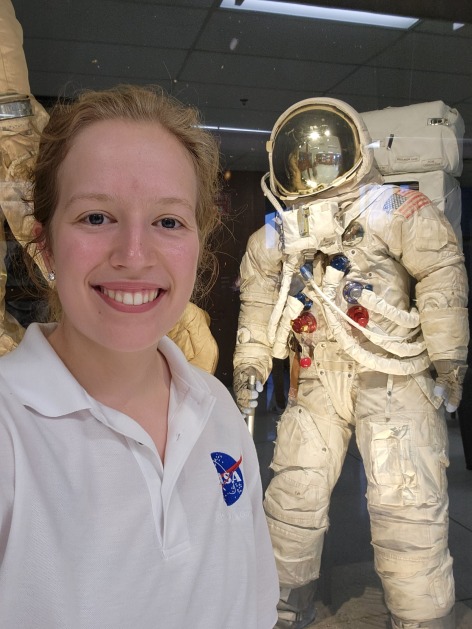AMES, Iowa – Sarah Stewart set her sights on an internship with NASA before she even enrolled at Iowa State University.
Space exploration captured Stewart’s imagination at an early age. She built model rockets as a child and remembers going outside with her dad to watch the International Space Station sail across the night sky. She longed to play a part in the grand human endeavor to learn what’s out there.
“We’ve explored every corner of the Earth, and now we’re looking beyond,” Stewart said. “The exploration aspect of it is so exciting for me.”
Stewart, a senior studying mechanical engineering at Iowa State University, spoke those words during a video call from her workspace at NASA’s Johnson Space Center in Houston where this summer she’s completing her third NASA internship. She’s gathering data that could help pave the way for manned missions to Mars, and she’s contributing to studies about how to mitigate the deleterious effects of lunar dust on sensitive equipment and instruments.
And the personal connections and opportunities to innovate provided by Iowa State served as the launching pad that put her on her trajectory to the stars.
Iowa State connection launches into NASA internships
The strength of Iowa State’s engineering and space programs drew Stewart, originally from North Liberty, to become a Cyclone. Virtually from the moment she moved to Ames, she began asking her professors what it would take to earn an internship at NASA. She contacted the Iowa Space Grant Consortium, of which Iowa State is a core member. The consortium connects Iowans with NASA-relevant research opportunities and internships. Stewart also joined the Make to Innovate program, which allows ISU students to create solutions to real-world aerospace challenges. The program qualifies for course credit and encourages participants to get hands-on with complex engineering problems.
The summer after her first year at Iowa State, Stewart landed an internship through NASA’s Office of Stem Engagement working remotely for NASA’s Goddard Space Flight Center in Maryland helping with the design of components for a balloon-borne astrophysics telescope that will study star formation rates.
“I knew an internship was something I really wanted to do, and I knew if I wanted it to happen I would have to take the first steps,” she said. “You can’t just wait for an opportunity to come to you. You have to work toward it and make connections.”
Later, Stewart earned a spot in NASA’s Pathways Internships Program, which allows students to enroll in multi-semester experiences that cover various roles and positions. During her first semester in the program, she studied the power and external thermal systems for the International Space Station. Stewart got to sit in mission control alongside NASA flight controllers for missions to the space station. She also got to work with astronauts training for emergency scenarios on the station.
For a self-proclaimed space nerd, it was a dream come true.
This summer, she’s gathering data that could inform future manned missions to Mars. She's also testing a detector sensor using a substance that simulates lunar dust in a thermal vacuum chamber that mimics conditions on the moon. Since lunar dust is abrasive, clogs mechanisms and can interfere with scientific instruments, it is important to test hardware in simulated lunar environments, Stewart said.
Witnessing space exploration history
Among Stewart’s favorite experiences as a NASA intern was the launch of the Artemis I mission last November. The Artemis rocket took off from the Kennedy Space Center in Florida before its Orion spacecraft separated from the rocket to circle the moon and return to Earth. The mission is expected to lead to the eventual return of crewed missions to the moon, the first such missions since the conclusion of the Apollo program in the 1970s.
Stewart took in the historic launch along with dozens of her fellow NASA interns during a special launch party at the Johnson Space Center.
“The energy in the room was so great. We all just stood together, hugging each other as we watched the rocket launch,” Stewart said. “It was so much fun. I didn’t get home until 3 a.m. and then got up for work the next day. Actually seeing the launch makes you realize it’s real.”
She’ll complete her current internship in August and move back to campus to continue her studies at Iowa State. Next spring, she’ll return to NASA’s Johnson Space Center for another internship rotation.
The NASA Pathways Internships Program selects interns to align with the agency’s future workforce needs, and Stewart hopes her experience could open the possibility for a full-time position. But even if it doesn’t, she said she knows she wants a career that will allow her to solve real-world engineering problems and make a difference. And everything she’s learned at Iowa State and NASA will prepare her for whatever comes next.
“My dream job is to work as an engineer for NASA or somewhere else working on space exploration,” she said. “But I also have an interest in biomedical technologies. I just love learning about science and solving problems.”
